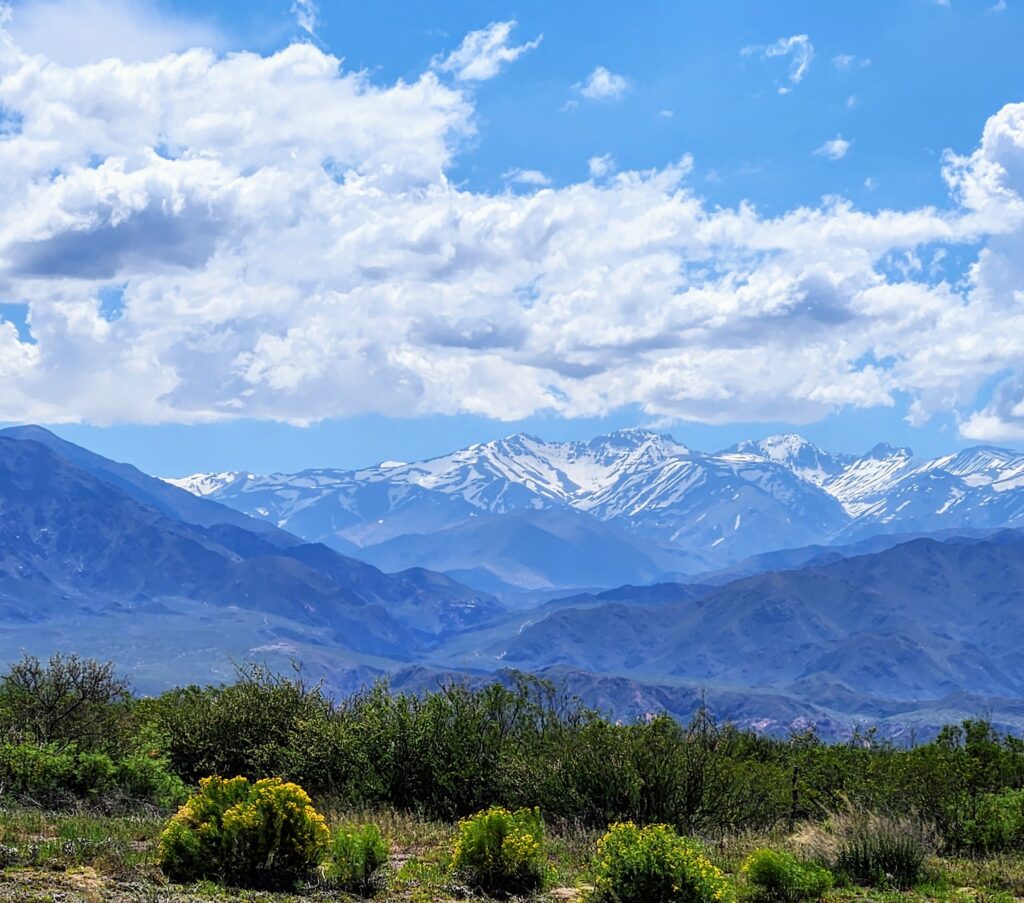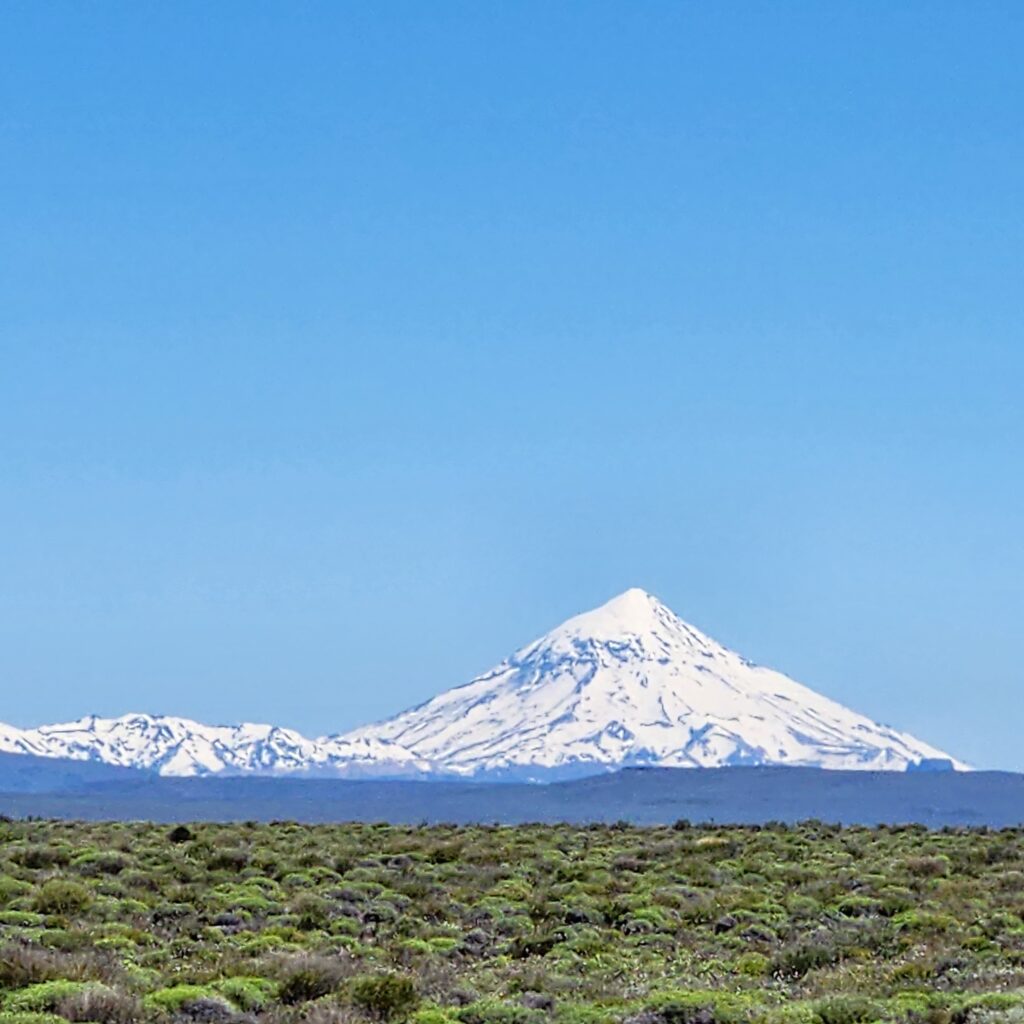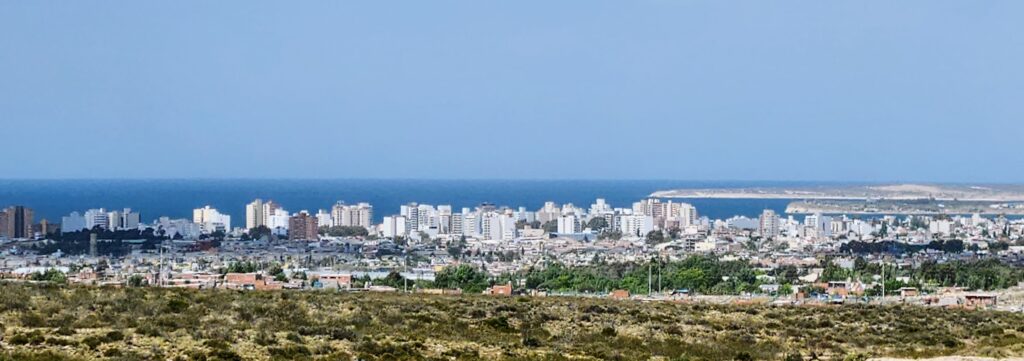NOVEMBER 2023 PATAGONIA TRIP SUMMARY
NOVEMBER 2023 PATAGONIA TRIP SUMMARY Read More »
OUR SOUTH AMERICAN LIFE
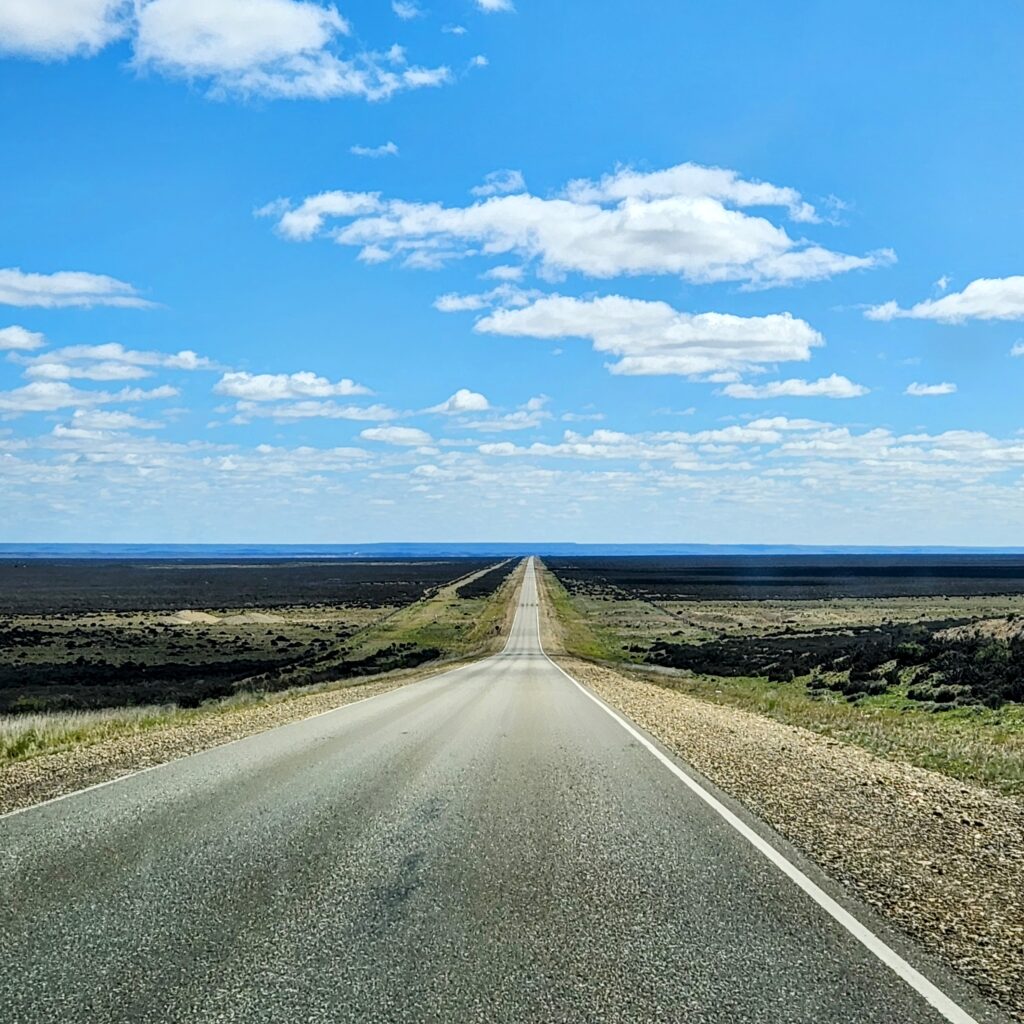
Thanks to you all for following along. We were greeted with the dogs’ enthusiastic jumps, barks and craziness upon our return home.
For those of you who prefer to view the photos only and forgo my sometimes long and dry narrative, here is the photo/video link to the entire trip:
NOVEMBER 2023 PATAGONIA TRIP SUMMARY Read More »
We had come this route on the way south, so I figured we were in for the same old terrain with no surprises. However, with the difference in light and the seasonal change, it turned out to be quite different than anticipated.
On the way out of Chos Malal, the road immediately rose around and up a mesa with an absolutely incredible Andes backdrop, and we came into green, desert scrub leaving the trees below. Then we slowed for a herd of goats to cross Route 40, an odd sight over the blacktop on a major highway, but not long ago it was dirt. We had endless, additional mesas and brown plateaus for hours with more up and down and around on very curvy roads. We saw fertile grasslands, trees, and small lakes in valleys, rocky, dry desert sediment with no life on the mesas, except occasionally the route was punctuated with yellow flower clumps; no more Calafate, so wild daisies, maybe? After many hours, we finally came down into a vast, multicolored low valley surrounded by rock formations and the outline of the Andes to our west and we straightened out and turned due North.
LINK TO CHOS MALAL to MENDOZA LEG IS HERE:
CHOS MALAL – MENDOZA Read More »
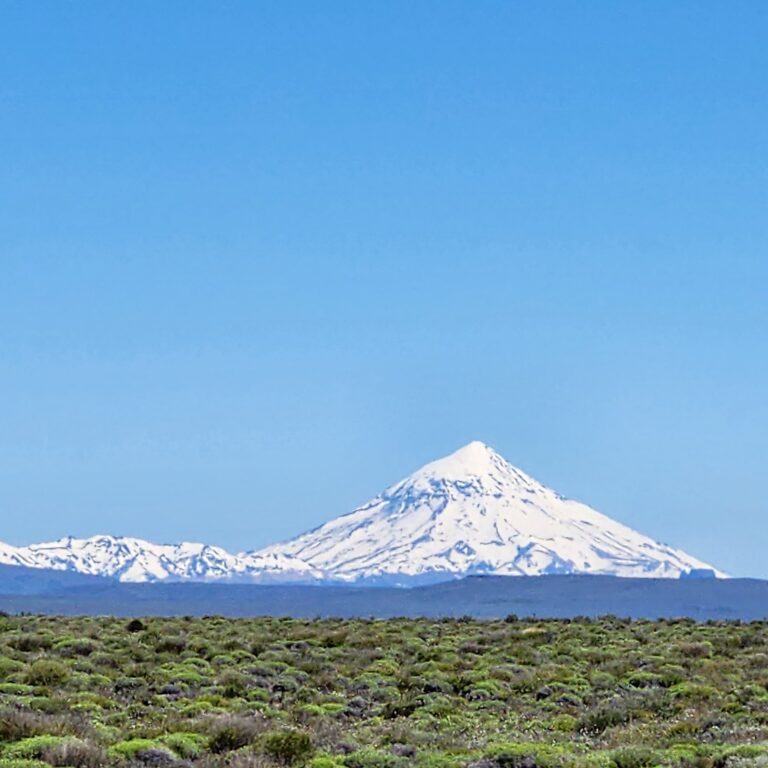
We were on the road again at 9:30, and we took The Road of the Seven Lakes (Camino de los Siete Lagos) is the popular name given to the scenic portion of National Route 40 between the towns of San Martín de los Andes and Villa La Angostura in the Neuquén Province. And it was slow going because it was a Saturday, because the high season is just beginning, and because there were more bikers on the road than I’ve ever seen in one place…peletons every kilometer! But no matter, the scenery really is lovely. So, we slowly wound up forested roads and down valleys and hills, with white peaks above and lakes scattered throughout the drive. We saw deer crossing signs, occasional waterfalls crossing the road, and the stunning yellow of the Calefate flowers lining the route again.
VIDEOS/PHOTOS VILLA LA ANGOSTURA to CHOS MALAL LEG IS HERE:
VILLA LA AGOSTURA – CHOS MALAL Read More »
We left early, and after the same green, desert brush for a couple of hours, we climbed uphill among yellow wildflowers lining the road and lots of sand. Then, quite quickly, we came upon multiple red hills in the distance a first and then closer—the Cerros Colorados, to our northwest and then we passed a few small lakes and lots of grasslands and desert flora, then up onto another mesa, the Meseta de Colitoro and then down into several small towns, and more salt flats amidst the desert. Plus, we had another several hours of high desert until we came into the town of Ingeniero Jacobacci, another old rail town, where we filled up on gas and a sandwich.
Then it was up and down and in between green desert and grass-covered, red rock escarpment, and more sheared sheep in addition to cattle and horses. For the rest of the way we had various detours onto dirt roads and then back again to asphalt along Route 23, which is in the middle of a very long and very complicated effort to pave the rest of the road into Bariloche. Finally, with 2 hours to go, we had our first glimpse of the snow-covered mountains of the Lake District to the west ahead as we descended the mesa.
We have 2 nights in Villa La Angostura. It is considerably larger and much more of a resort town than the last time we were here, 10 years ago. One of the staff said that during the pandemic it really exploded. With the goal being to avoid as many tourists as possible, and given that our hotel room looks right out on Nahuel Huapi Lake, we decided to forgo some sort of excursion (of which there are many, and some we have done on past visits), and instead take a short walk and relax on our extra day. So, we slept late and set off down the path lining Route 40 to the turn-off to Rio Correntoso, which connects Lake Correntoso with the large, sprawling Nahuel Huapi Lake. Apparently, it is the shortest river in the world, as you can see from the map. As in all of the Bariloche region, the views are spectacular, and in particular, at this time of year, the glorious, yellow Calefate flowers (the same we saw all over Chile and southern Patagonia)are everywhere in full bloom!
THE PHOTO/VIDEO LINK OF THE LAS GRUTAS toVILLA LA ANGOSTURA LEG IS HERE:
https://photos.app.goo.gl/WDLDqPR3gadvVbF3A
El Faro Botique Hotel and Spa: : Rated highly by all accounts, constructed into the hill that rises up from Lake Haupi, the main selling point is the view, which is nothing short of amazing. However, in addition, the room was spacious and very comfortable, the bathroom included a jacuzzi overlooking the lake, the food was excellent and the staff fabulous.
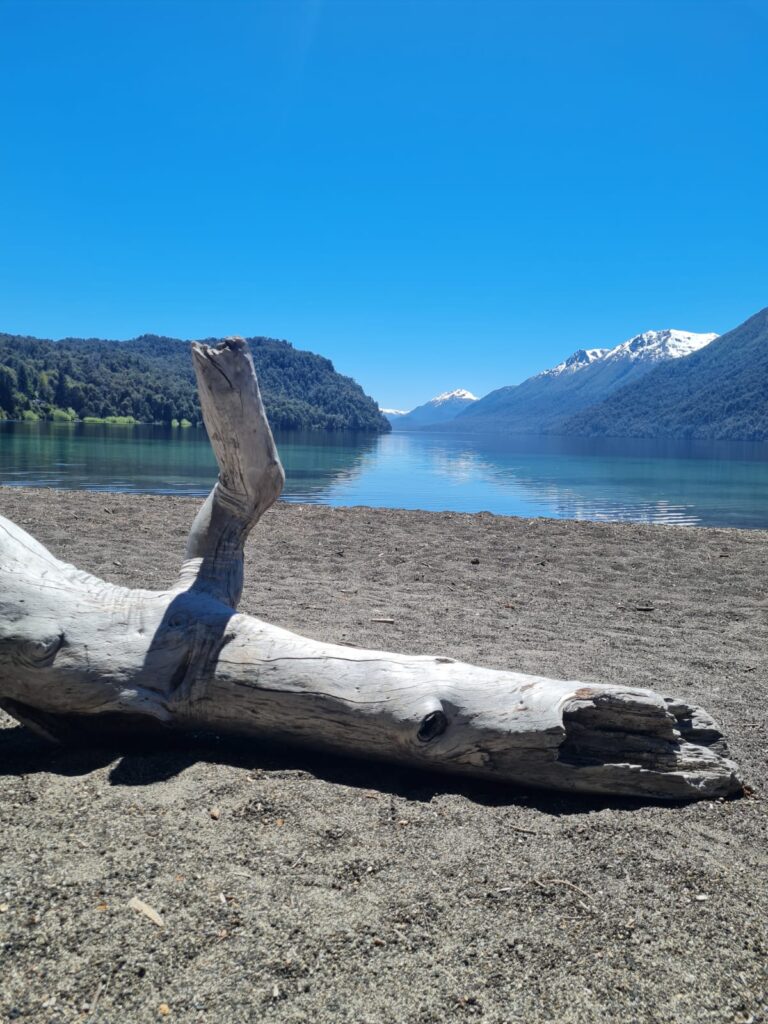

LA GRUTAS – VILLA LA AGOSTURA Read More »
With just a short, two-and-a-half-hour drive ahead, we drove back up to the plateau to the familiar, endless desert brown grass and wind farms, although now at least we were graced with several hills. We climbed steadily through a few rock formations and then back down into Sierra Grande, a very small town.
Our destination for the night was an Airbnb beach house in Las Grutas, a resort town on the Gulf of San Matias known for its relatively warm water in the Patagonian summer. We found the place in a neighborhood of mostly unoccupied vacation homes set back from the water. This definitely turned out to be the most questionable rental we’ve had yet, a two-story, very shoddily constructed ‘house’ with the living quarters above and two small bedrooms below. Knox remarked that the stairs were absolutely not up to code, and I could list several other issues, but I won’t. The ocean breeze was blowing off the Atlantic and the guy who met us to give us the keys suggested we check out the beach, a 10-minute ride away, and he highly recommended a spot for fresh seafood, Terramare.
So, we unloaded and headed out. When I booked the Airbnb, my only intention was to stay in Las Grutas to break up the very long trip across the country from east to west, our next stop being Villa La Angostura, near Bariloche. What I did not realize then, nor when we arrived, was that we had landed in a beach resort town that fills up with tens of thousands of tourists in December and January; but, at this time of year, late November, there was no one in town. Again, it seemed, we had the whole place to ourselves.
Until…we found TerraMare, which was full to the brim with retired tourists from Córdoba. So it was the two of us and many friendly, lovely, talkative, mature women from Córdoba. A fantastic time! In fact, the place was a dive and a gem…a plethora of photos on the wall of Maradona and Messi of course, plus the Stones, Freddy Mercury, the Argentine rock sensation, Charly Garcia, and, oddly, an old promo photo of the 60s TV show Get Smart, that I watched in syndication when I was a kid and loved. And the food, especially the salmon empanadas and the cazuela de mariscos, which featured a ton of mussels, was fantastic. After lunch, we took the stairs down from the sea wall to the beach. In sum, I knew I missed seafood, living in Mendoza, and so we enthusiastically welcomed the meal, but I had forgotten how much I miss the ocean. And this afternoon we were treated to an absolutely gorgeous gift of one, as you can see from the photos!
THE LINK TO THE PUERTO MADRYN to LAS GRUTAS IS HERE:
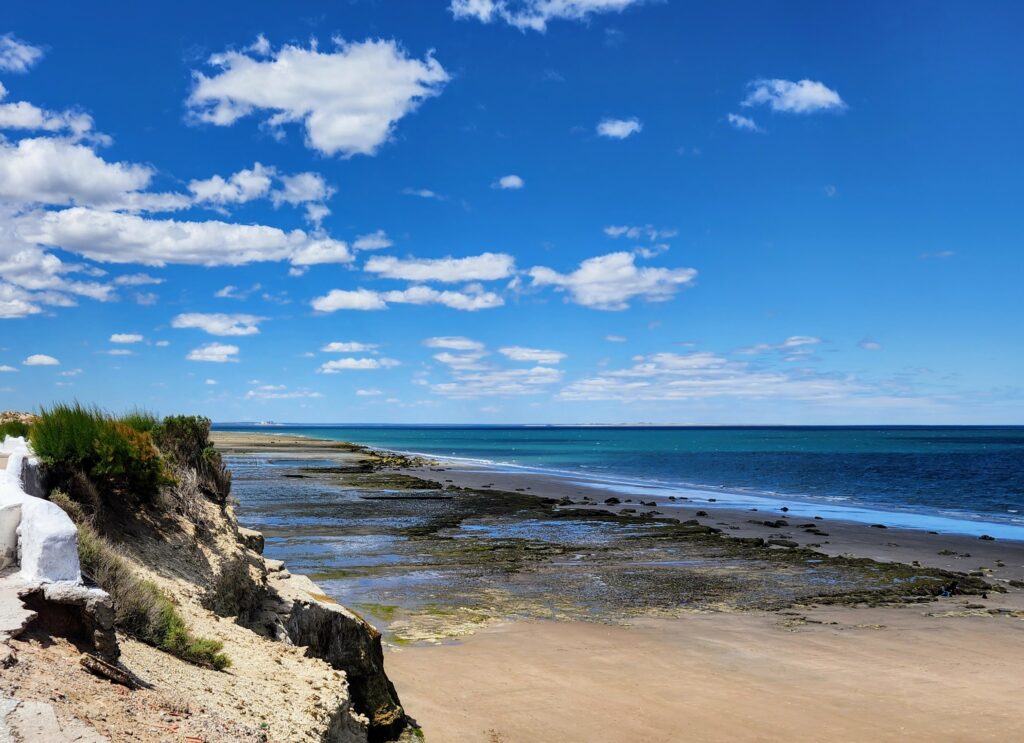
PUERTO MADRYN – LAS GRUTAS Read More »
We had a 5-hour drive ahead and so in high winds, we left around 10:30 to have some time to relax in Puerto Madryn. A divided lane highway along the coast out of town passed oil refineries and other industries, and then we came up onto two-way route 3 with rolling, green, desert, scrub hills (again, reminiscent of Texas) as the road turned inland all the way to Puerto Madryn. We were driving in the highest winds we’ve encountered yet and more bad roads added to the challenging driving. And in the midst of the ridiculous winds, we were now thinking “Oklahoma, where the wind comes rolling down the plain,” or Kansas.

COMODORO RIVADAVIA – PUERTO MADRYN Read More »
After breakfast, we took a brisk walk in sunny, 8-degree Celsius weather 5 blocks to the comisaría (police station) to officially get our authorization of “no emision de voto,” (non-casting of vote) that says we are too far away from our place of residence to vote. We packed up and were on the road by 10 a.m.
Heading out of the Rio Gallegos westward with the River Gallegos to our right and its cliffs rising up behind the remaining warehouses and industry we passed, again we climbed up to the coastal plains and more prairie, now reminding us of parts of Texas — straight, flat and dry for miles and miles with occasional undulating prairie, but with guanacos everywhere (they are difficult to photograph because they gallop off so fast). As Route 3 moved closer to the ocean, the brown grasses gave way to greenish shrubs extending as far as the horizon. Knox was happy with the Santa Cruz Province roads, which are in superb condition.
For a moment we came down into a valley and the highway led us through a beautiful mini estuary full of flamingos, cormorants and all manner of birds feeding and fluttering about. A bit further over a rise, another inlet revealed a sandy riverbed that looked like at one time it had been full of water. A steady climb up rolling brown and green hills returned us to the coastal plain. An hour or so later we entered Monte Leon Park, the green scrubby plains continued and then wound around rolling hills, the road lined by low white and yellow wildflowers and numerous guanacos and sheep near the road. To the northwest, black shapes like mesas or buttes rose, shimmering, far in the distance.
We came over some more hills dropping off the plateau to, finally, the ocean, we thought. But we had arrived in Puerto San Julian at low tide so we could barely see the water in the distance past the sand. As we circumvented the city, more warehouses went on for ages on the edge of town, and we passed a salt lake and climbed up again to more high plains, and more wildflowers. Our cruising speed was about 160 kph.
We chased a pack of four motorcycles for a long while at a very fast pace with guanacos and horses grazing in the distance as we whizzed by. We passed the motorcycles and the landscape turned desert brown again with hilly mirages looming on the horizon, hazy, white, wispy clouds hanging low and blue slivers peeking through. Still, very windy.
The great roads did not stretch the length of Santa Cruz Province. Crossing into different counties (“departmentos”) often meant a drastic change in road conditions, from smooth to quite poor. We were forced to swerve left and right with oncoming trucks doing the same to avoid potholes for stretches at a time. The landscape was more of the same, dry desert, kilometer after kilometer.
Just before we reached the town of Fitz Roy we had a glimpse of windmills, probably a large wind farm to the east on the coast and then we were back up to the plateau, and yes, more sheep and no change except for occasional saline ponds with dozens of flamingos wading. Finally, for real, the ocean shore came into view and sandy dunes dropped off to our right and the ocean town of Caleta Olivia was in front of us up the hill overlooking the water. On the outskirts of the city, unfortunately, the roads were lined with trash for some kilometers, the first littered landscape we have seen. The main drag stretches along the sea wall, lined with businesses, hotels and some restaurants with the residential streets pitching uphill to our left. Pretty deserted and drab in the cloud cover, but probably because it was Sunday.
The last stretch leading to Comodoro Rivadavia is along the ocean with dunes above giving way to more plains and salt flats to our left, with the afternoon light giving a shimmer to the ocean horizon ahead. The long Rivadavia boardwalk along the ocean led us to our destination for the night, the Austral Plaza Hotel. After Knox’s speedy driving, we arrived much earlier than anticipated and had some time to rest before heading to a local place for a steak dinner and then back to the hotel to watch the new President-Elect of Argentina give his acceptance speech.
LINK TO PHOTOS/VIDEOS OF RIO GALLEGOS to COMODORO RIVADAVIA LEG IS HERE:

RIO GALLEGOS – COMODORO RIVADAVIA Read More »
We were on the road by 9:30 in steady rain turning to sleet and snow (leaving the city border, a traffic cop told us to drive “con mucho precaución!”) We climbed back up route 3 (rt 40) to the pass and retraced most of our trip down from Rio Grande back to the ferry to leave the island of Tierra del Fuego. To do so one must pass through Chile (into and then out again) because the Strait of Magellan crossing is controlled by Chile. So, on top of the long drive, we were looking ahead to two rounds of immigration and customs.
Sun peered through clouds over the Atlantic with its waves pounding the beach as we continued north up the coast before turning west and then north again to Rio Grande and onto the ferry. We were fortunate with the timing and arrived just 5 minutes before they began boarding under very cold, gray skies with high winds and waves.
Once off the ferry, we had 45 minutes to the border, an hour or so through the various immigration and customs lines and then another 45 minutes to Rio Gallegos. There is nothing different to describe: just the same brown, flat coastal prairie land with a few small, oddly shaped hills here and there sticking up on the horizon and no mountains in sight. Windy with lots of guanacos in herds, more sheep and 6 degrees.
The wind was so strong that when the big tractor-trailer trucks came at you and passed from the other direction there is a big shudder and a whoosh sound like you were flying through a tunnel, which takes some getting used to.
Rio Gallegos featured endless warehouses as we drove in, a flat, drab, low sprawling part of town but full of colorful houses, and a huge soccer stadium. The large city center is very pleasant with a nice plaza, lots of shops and restaurants. The city is home to around 100,00 people and sits on the estuary of the River Gallegos.
We arrived at 7p.m. and found a parking spot right in front of the hotel and unloaded. The desk attendant recommended a restaurant nearby that would serve us a drink until 8pm. This being the night before the election, Argentina law mandates that all alcohol sales stop at 8pm for 24 hours. We got our order in and paid with just 2 and a half minutes to spare (note the time on the photo of the receipt). The waiter handed us the receipt, telling us to keep it handy to show to the police if they showed up! The restaurant, Britanico. featured a 1911 picture of George McGeorge, the founder of the British Club, which apparently still exists in Rio Gallegos. The food and the wine were very good, very inexpensive and much more French in style than British.
LINK to PHOTOS from USHUAIA to RIO GALLEGOS LEG:
https://photos.app.goo.gl/i3G66vNPDw1c2Nyk8
Also, don’t forget to go back to the Ushuaia post to see the Penguin photos and videos (just posted!
Amerian Rio Gallegos Hotel: a recently remodeled hotel, with spacious rooms that include a sitting area and kitchenette. Unfortunately, the heating system was in overdrive and so we had to sleep with all the windows wide open to the street and the sound of traffic and a cacophony of city noise was unavoidable all night. Shower rather weak and warm rather than hot, and the breakfast basic, but the staff was lovely.
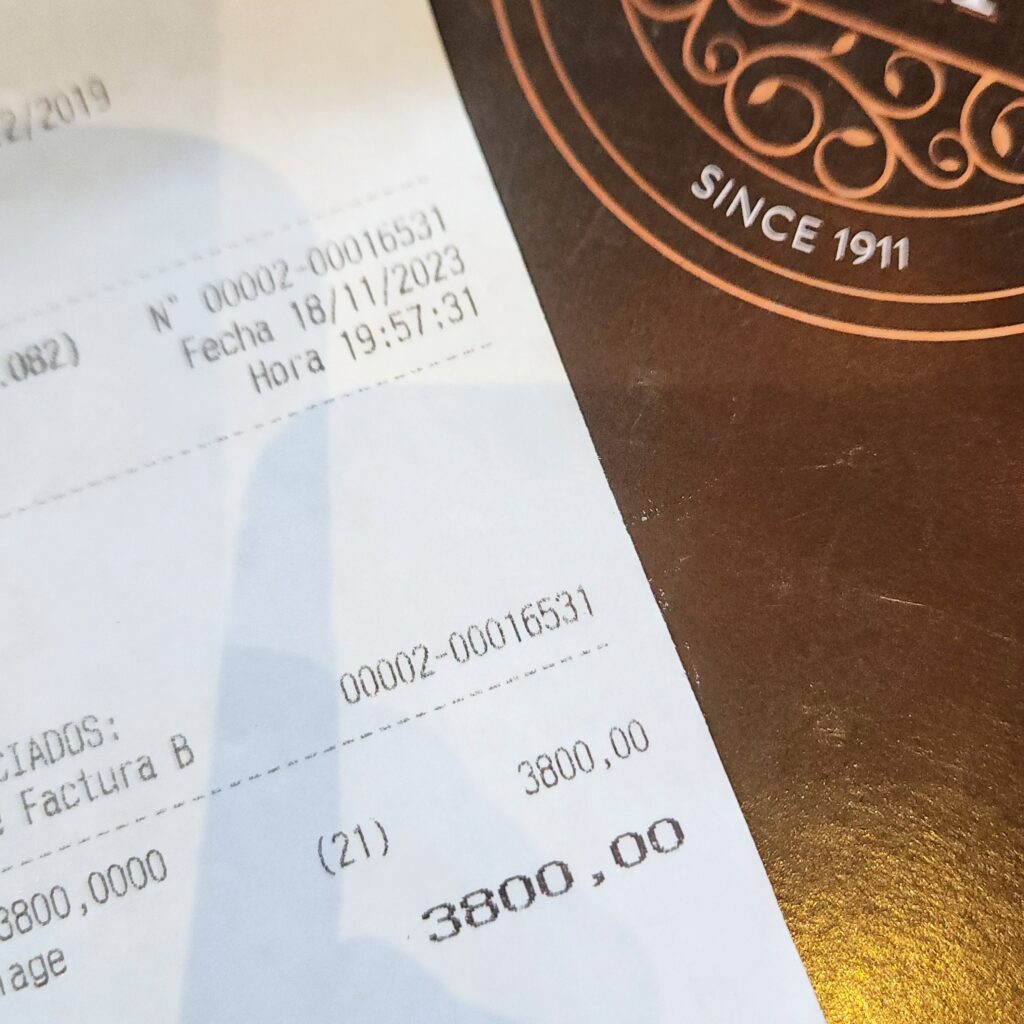
USHUAIA -RIO GALLEGOS Read More »
Nov 15, Rio Grande to Ushuaia
We had a late start; after coffee and breakfast and a gas stop, we were on the road by 11:30. The wind and the big sky continued under partly cloudy skies, and the temperature hovered around 8 degrees Celcius.
THE PHOTO DUMP FOR THE RIO GRANDE TO USHUAIA LEG IS HERE:
https://photos.app.goo.gl/QAWLWTTQYR3kx7AJ7
We had a scheduled tour to Harberton Ranch and Martillo Island, where two species of penguins live and nest. In the pouring rain, we registered for the prebooked 7-hour tour of the Estancia, the Island and the history museum. The bus took 90 minutes to get to the dock, and after a short boat ride, we had ample time on the island in a group of only 20 people (they allow no more at a time) to learn about and photograph the penguins. Two distinct species of penguins are currently mesting on the island, the Magellanic Penguins and the Gentoo Penguins. The former is smaller in stature and digs nests into the ground, has only the black and white coloring and comes to the island only in the spring to mate and lay eggs. The latter is taller, nests on the beach without digging big holes is distinguished by its orange beak and feet, and lives on the island year-round. We were very fortunate in two regards: although it was raining, we had calm conditions (the day before they had 50kph÷ winds); and, a third species, the King Penguin, was present on the island during our visit, and only one single individual (he has the yellow head coloring in the photos). Apparently, they are a young colony and have shown up a few seasons over the past years, and today, this guy was scouting and considering the island as a place to bring his colony to nest. He hardly moved, standing tall among the others the whole hour we were on the island.

RIO GRANDE – USHUAIA Read More »
Nov. 14, Torres Del Paine to Rio Grande
We were on the road around 9:15, in 3 degrees, rain and sleetand with very little visibility (we lucked out having seen the towers; today there are many tourists who will see only fog and rain and sleet and snow, and no view). We climbed back up the mountain past Lago del Toro to our left, tracking back away from Torres del Paine, and we had at least 1.5 hours of sleet and snow that finally let up as we pulled into Puerto Natales for gas.
We continued southeast on Route 9. with more rain and sleet and intermittent sun. The prairie was very flat with very short trees resembling mesquite (will explain more about these later). Soon, we drove up in altitude to bare, high plains again with more sheep and cows scattered in every direction (I thought I had seen a lot of sheep before this, but no!)

TORRES DEL PAINE – RIO GRANDE Read More »
